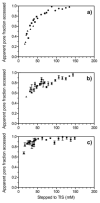Characterization of cross-linked cellulosic ion-exchange adsorbents: 1. Structural properties
- PMID: 24188996
- PMCID: PMC4143382
- DOI: 10.1016/j.chroma.2013.10.003
Characterization of cross-linked cellulosic ion-exchange adsorbents: 1. Structural properties
Abstract
The structural characteristics of the HyperCel family of cellulosic ion-exchange materials (Pall Corporation) were assessed using methods to gauge the pore dimensions and the effect of ionic strength on intraparticle architecture. Inverse size exclusion chromatography (ISEC) was applied to the S and STAR AX HyperCel derivatives. The theoretical analysis yielded an average pore radius for each material of about 5nm, with a particularly narrow pore-size distribution. Electron microscopy techniques were used to visualize the particle structure and relate it to macroscopic experimental data. Microscopy of Q and STAR AX HyperCel anion exchangers presented some qualitative differences in pore structure that can be attributed to the derivatization using conventional quaternary ammonium and salt-tolerant ligands, respectively. Finally, the effect of ionic strength was studied through the use of salt breakthrough experiments to determine to what extent Donnan exclusion plays a role in restricting the accessible pore volume for small ions. It was determined that Donnan effects were prevalent at total ionic strengths (TIS) less than 150mM, suggesting the presence of a ligand-containing partitioning volume within the pore space.
Keywords: Cellulosic materials; Donnan equilibrium; Electron microscopy; Inverse size exclusion chromatography; Ion-exchange chromatography; Salt-tolerant adsorbents.
Copyright © 2013 Elsevier B.V. All rights reserved.
Figures











References
-
- Peterson EA, Sober HA. J Am Chem Soc. 1956;78:751.
-
- Graham EE, Fook CF. AIChE J. 1982;28:245.
-
- Peterson EA. In: Laboratory Techniques in Biochemistry and Molecular Biology. 1. Work TS, Work E, editors. North-Holland Publishing Company; Amsterdam: 1970.
-
- Bai YX, Li YF. Carbohydrate Polymers. 2006;64:402.
-
- Boeden HF, Pommerening K, Becker M, Rupprich C, Holtzhauer M, Loth F, Müller R, Bertram D. J Chromatogr A. 1991;552:389. - PubMed
Publication types
MeSH terms
Substances
Grants and funding
LinkOut - more resources
Full Text Sources
Other Literature Sources

